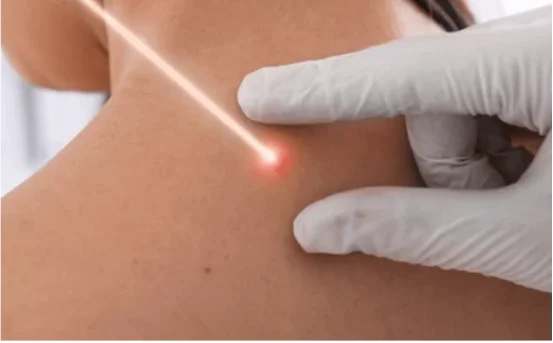Today, both patients and healthcare professionals look for treatments that are quick, effective, and as gentle on the body as possible. Laser surgery, or what is laser surgery, has emerged as one of the breakthroughs that meet those demands, changing how many common operations are carried out. Whether it is reshaping vision, tightening skin, or targeting tumors, laser techniques help people recover more quickly, with less discomfort, and often in outpatient settings.
At its core, laser surgery relies on a narrow beam of light that is powerful enough to cut, shrink, or destroy tissue. Because the beam can be precisely directed, surgeons can work on very small structures without disturbing nearby cells, a feat that traditional scalpels may not match. The letters in “LASER” summarise the science: Light Amplification by Stimulated Emission of Radiation. Different wavelengths of light produced by the device interact with tissue in complementary ways—some cut like a knife, others seal blood vessels, and still others entirely vaporise targeted areas.
Why do so many doctors turn to laser surgery these days?
Understanding What is Laser Surgery
The answer comes down to a handful of advantages that make lasers a good fit for a surprising range of procedures.
First, there is the minimally invasive nature of the technique. Many laser operations require just tiny openings, or sometimes none at all. Because there is less trauma to the body, patients often experience lower pain levels, lose less blood, and find their recovery speeds up. This quick-healing benefit is especially appealing to people juggling work, family, and everyday life.
Second, lasers excel in situations where extreme precision is a must. Think of eye surgery, brain procedures, or the careful removal of small tumors. The focused beam cuts with such accuracy that doctors can treat a problem without disturbing the healthy tissue right next to it. That level of control simply isn’t possible with a scalpel alone.
Cosmetic applications provide a third major reason for choosing laser surgery. Dermatologists and plastic surgeons use lasers to smooth out scars, erase wrinkles, lighten tattoos, remove unwanted hair, and even tighten sagging skin. Patients appreciate the minimal downtime and the gradual, natural-looking improvements that often follow.
Lasers have also carved out an important role in cancer care. Specialists can direct a concentrated beam to shrink or destroy tumors in the cervix, lungs, skin, and other organs. In some cases, the treatment may serve as a primary option; in others, it acts as a helpful complement to surgery, chemotherapy, or radiation.
Finally, vision correction remains one of the best-known uses. Procedures like LASIK and PRK reshape the cornea with remarkable speed, allowing millions of people to trade glasses for clearer, unassisted sight.
Lasers have become valuable tools in modern medicine because their focused energy lets doctors treat tissues with remarkable precision. The type of laser a physician chooses usually depends on the specific tissue they’re working with and the condition being addressed.
One of the most familiar varieties is the CO2 laser. Its beam is highly effective for skin resurfacing, allowing for the careful removal of damaged skin layer by layer. Surgeons also rely on it for wart removal and for cutting through soft tissues during operations in areas like the throat and nasal passages.
Then there’s the YAG laser, often spotted at eye clinics. It can quickly clear up cataracts and address other eye problems, while also finding a place in dermatology to seal off problematic blood vessels.
Another lightweight contender is the argon laser. Although less flashy, it plays a crucial role in retinal treatments and in calming down certain vascular skin issues, like the small, red spider veins that some people develop.
Finally, we have the excimer laser, which emits ultraviolet light. This high-energy beam has revolutionized refractive eye surgery, most famously LASIK, by carefully reshaping the cornea and, in turn, reducing patients’ dependence on glasses or contacts.
Common Procedures That Use Laser Surgery
When people hear about laser treatment, they might first think of correcting vision, but lasers now help with many medical issues. Eye procedures like LASIK and PRK are among the most well-known, allowing patients to trade glasses for clear sight with just a thin flap in the cornea. On the skin front, lasers resurface the face, smooth away acne scars, and even soften the telltale lines of aging.
In the kidneys, laser lithotripsy breaks stubborn stones into sand-sized grains, letting them pass easily. Varicose veins can also be treated through the skin; a thin fiber is threaded into the vessel and the beam seals it shut. For men bothered by an enlarged prostate, laser techniques trim excess tissue with minimal downtime. Dentists, too, have adopted the technology for gum procedures and to give pearly-whites an extra pop through whitening.
Surgeons are increasingly using lasers to remove tumors, directing light-sensitive drugs for precision destruction. Although each application looks different, the underlying principle is the same: concentrated light energy gets the job done with pinpoint accuracy.
How Laser Surgery Works: The Procedure
If you’re scheduled for laser treatment, the experience starts long before the beam is fired. At the first visit, doctors run imaging, take measurements, and explain every step. Once everyone agrees on the plan, a consent form is signed, and pre-op guidelines—such as fasting or stopping certain medications—are given.
When the day finally arrives, patients are usually seated in a comfortable chair or wheeled into the operating room. Depending on the procedure, they may get local numbing, light sedation, or general anesthesia. The surgeon then steadies the laser, which may be blended with cameras or robotic arms, and guides it to the target tissue. In seconds, cells are either cut, vaporized, or sealed, often leaving very little blood behind.
Recovery tends to be brief. Many patients are monitored for only a short while before heading home with a friend or family member. Instructions about pain relief, activity limits, and follow-up visits are tailored to match the exact method used.
Benefits of Laser Surgery
Lasers have captured the surgical spotlight for several compelling reasons. First, their precision means healthy tissue escapes damage, trimming potential complications and scarring. Second, because there is less overall trauma, patients report minimal pain and bleed far less than they would after a scalpel. Finally, smaller entry points speed up healing, so life can get back on track in days instead of weeks.
Less Chance of Infection Lasers create a sterile zone around the target tissue, which lowers the risk of germs settling in after the procedure. Better Cosmetic Results Laser techniques usually leave finer marks behind, making them popular for skin and plastic surgeries where appearance matters. Possible Downsides Despite their reputation for safety, lasers aren’t without pitfalls: Poor aftercare can still invite infection. A procedure aimed at smoothing skin may leave minor burns or discoloration. Eye surgery might yield an undesirable prescription if settings are off. Some conditions or patients simply aren’t good candidates. A qualified expert is the only one who can tell you if laser work makes sense for you. Laser vs. Standard Surgery Side by Side Feature Laser Procedure Traditional Procedure Invasiveness Tiny ports or beams Bigger cuts Recovery Speed Days instead of weeks Weeks instead of days Bleeding Minimal More Accuracy Machine-guided Very skill-dependent Infection Rate Lower Higher Scarring Thin line Possible stripe Who Should Consider It People who: Need pinpoint precision in treatment. Want to get home sooner, not linger in bed. Would rather skip a big incision. Desire cosmetic touch-ups with the least fuss. Can’t manage long healing times due to age or illness. Always finish screening before booking an appointment.
Conclusion
Laser surgery has changed the game for doctors and patients alike. By focusing light with incredible accuracy, these treatments can be quicker, safer, and less traumatic than many older operations. From clearing up vision problems to targeting stubborn tumors and turning back the clock on our skin, lasers deliver strong results while keeping complications to a minimum.
And the field is still moving forward. As imaging gets sharper and laser tools become smarter, we can expect even wider use of these techniques. That means lighter bandages, shorter hospital stays, and a healthcare experience that feels friendlier and more in tune with what people want.
If you are thinking about stepping into the world of laser treatment—whether for health or for cosmetic reasons—make it a priority to sit down with a board-certified professional. They can walk you through what the procedure involves, what risks you might face, and how long recovery will really take based on your personal health story.























